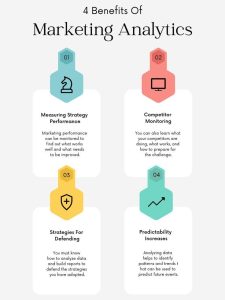
Marketing Analytics: Definition, Tools, Benefits
In 2025, businesses compete in one of the most data-driven environments ever, and marketing analytics has become a key factor. Companies no longer rely only on intuition. Instead, they use insights to connect with the right audience, at the right time, with the right message. Before diving deeper, many marketers ask: what is marketing analytics and why is it important now?
At its core, marketing analytics is primarily concerned with measuring, managing, and analyzing marketing performance. With this analysis, however, businesses intend to capitalize on enhanced efficiency and optimized return on investment (ROI). The understanding of customers' behavioral patterns and campaign information allows companies to know not just what is happening but also why it is happening, thus enabling them to modify their strategies on the spot.
In this blog, you will get a detailed understanding of marketing analytics. We will proceed with a clear definition of marketing analytics; we will further discuss the importance of marketing analytics tools and finally speak about a handful of business advantages, establishing their importance. Whether you aspire to be a marketer thinking about improving campaign performance or a leader of the business focusing on growth, you should know marketing analytics so that in 2025 and beyond, you could be able to make smarter, data-based decisions.
Table Of Content
What is Marketing Analytics?
Why Marketing Analytics Matters Today
Core Components of Marketing Analytics
Popular Marketing Analytics Tools
Key Advantages of Marketing Analytics
Challenges in Applying Marketing Analytics
Future Trends in Marketing Analytics
Conclusion
Frequently Asked Questions
What is Marketing Analytics?
How it works is through monitoring customer interactions across channels—e.g., websites, social media, emails, and advertisements. These are plugged into marketing analytics platforms that structure, visualize, and explain the patterns. Businesses are then able to identify what is causing the engagement, conversions, and revenue.
Most importantly, marketing analytics extends past superficial metrics. It ties into larger business intelligence platforms to reveal more insights into the behavior, tastes, and lifetime value of customers. Not like old-school marketing, which was sometimes based on hunches or mass campaigns, marketing analytics makes it possible to target accurately and personalize.
In brief, marketing analytics is a move away from strategies based on instincts to making decisions on facts. It not only enables companies to comprehend what has happened previously but also forecast what is going to happen in the future, making it an essential tool for a sustainable future in 2025.
Why Marketing Analytics Matters Today
Today’s consumers interact with brands via websites, apps, social media, and emails, leaving behind lucrative streams of data. With the use of marketing analytics tools, businesses are able to trace the journeys, identify pain points, and provide tailored experiences. Unlike conventional approaches, marketing analytics allows for real-time monitoring and accurate measurement of what’s effective and what’s not.
A good example can be found among world leaders such as Netflix and Amazon. Both use marketing analytics to analyze customer viewing and purchasing habits and apply those findings to drive recommendations and targeted campaigns. Such personalized treatment drives engagement and encourages long-term loyalty.
Finally, the definition of marketing analytics captures why it’s important in 2025: it turns fragmented data into a roadmap for better decision-making. Companies that adopt marketing analytics can pivot fast, forecast customer demand, and build a winning advantage in a growing competitive digital economy.

*SalesPanel
Core Components of Marketing Analytics
After gathering this information, marketing analytics tools process it to segment audiences, create predictive models, and conduct attribution analysis that identifies which channels are driving results. Unlike traditional methods, marketing analytics provides deeper insights by connecting the dots across customer touchpoints. This connection allows businesses to optimize their strategies effectively.
The next stage is reporting and visualization. Dashboards and charts from marketing analytics tools enable marketers to track performance in real time and present findings in a clear, practical format. This shows that marketing analytics is not just about numbers but about turning them into meaningful insights.
Key metrics to track include ROI, conversion rates, customer lifetime value (CLV), customer acquisition cost (CAC), engagement rates, and churn. By continuously monitoring these metrics, marketing analytics helps ensure that campaigns are cost-effective, targeted, and focused on business goals. In summary, marketing analytics emphasizes an integrated approach to converting raw data into measurable business value.
Popular Marketing Analytics Tools
For web and campaign tracking, Google Analytics 4 is one of the most widely used marketing analytics tools. It provides insights into user behavior, conversions, and traffic sources. HubSpot Marketing Hub combines inbound marketing with CRM, giving marketers a single system to track leads and customer journeys. For data visualization, Tableau and Power BI turn complex datasets into interactive dashboards, illustrating marketing analytics as data-driven storytelling.
For SEO and competitor analysis, SEMrush and Ahrefs offer keyword tracking, backlink monitoring, and domain insights. Tools like Sprout Social and Hootsuite Analytics make social media engagement measurable, while Mailchimp Analytics focuses on email marketing performance, including open and click-through rates. These marketing analytics tools simplify measuring success across all digital channels.
It’s also important to distinguish between free and paid platforms. While tools like Google Analytics provide robust free options, advanced platforms like Tableau or SEMrush offer more detailed insights at a cost. Ultimately, the right marketing analytics stack depends on business goals, budget, and the level of detail needed. In every case, these tools represent the true definition of marketing analytics—turning data into actionable business intelligence.
Key Advantages of Marketing Analytics
1. Improved Decision-Making & Less Guesswork
Through marketing analytics, companies can make decisions based on evidence rather than guesswork and ensure strategies are supported by quantifiable evidence.
2. Better Customer Segmentation & Targeting
Through the application of marketing analytics tools, organizations can segment audiences, observe behavior, and reach the right customers with accuracy.
3. Maximized ROI and Campaign Effectiveness
The marketing analytics definition is centered around efficiency. Brands can monitor campaign performance in real-time and allocate budgets to high-performing channels.
4. Increased Personalization & Customer Experience
Through marketing analytics insights, companies provide personalized suggestions and experiences, enhancing customer engagement and loyalty.
5. Predictive Insights for Coming Strategies
Predictive modeling enables marketing analytics software to enable organizations to predict trends, anticipate customers’ needs, and plan ahead.
6. Competitor Benchmarking & Market Trends
Lastly, marketing analytics provides competitor benchmarking, with a clear vision of market movement and possibilities.
Ultimately, the marketing analytics definition captures a compelling dynamic: taking raw data and turning it into strategies that drive maximum ROI, individualization, and long-term business expansion.
Challenges in Applying Marketing Analytics
Compliance and privacy concerns also represent major hurdles. With stringent rules such as GDPR, businesses employing marketing analytics solutions have the obligation to keep customer information secure. This requires layers of cost and responsibility.
Another challenge is that there is not enough skilled talent. Marketing analytics is defined as high-level analysis, predictive modeling, and reporting, skills which take the right training and expertise. Small businesses struggle to hire or train employees for such positions.
Lastly, the exorbitant price of sophisticated marketing analytics tools is out of reach for SMEs. Sure, the advantages are clear, but affordability is a barrier. Nevertheless, companies that surmount these challenges can utilize the full capacity of marketing analytics, justifying the expenditure.

*Pinterest.com
Future Trends in Marketing Analytics
Looking ahead, marketing analytics will evolve quickly with new technologies and changing consumer expectations. When we ask, “What will marketing analytics look like in the future?”, the answer comes from the mix of AI, machine learning, and real-time data. The definition of marketing analytics is broadening to include predictive models that help businesses better understand customer needs.
Real-time marketing analytics tools will enable brands to change strategies on the fly, making campaigns more adaptable. Customer Data Platforms (CDPs) will become crucial for gathering data from various sources to create a complete view of each customer. Meanwhile, zero-party data—information that customers choose to share—will become more important as privacy-focused marketing gains traction.
Another trend is the use of generative AI to assess campaigns and provide creative suggestions. These advancements show that marketing analytics in 2025 and beyond will be smarter, faster, and more focused on customers, reinforcing marketing analytics as a tool for growth and trust.
Conclusion
To sum up, marketing analytics has changed how businesses function in the digital world. From explaining, “What is marketing analytics?” examining its tools, advantages, and challenges, it’s clear that marketing analytics is about turning data into practical strategies.
Marketers who take advantage of marketing analytics tools will make better decisions, see improved ROI, and build stronger customer relationships. The message is clear: businesses that fully harness marketing analytics will gain a lasting competitive advantage.
Now is the right time to explore modern marketing analytics tools, invest in training, and stay ahead. The future belongs to those who make data-driven marketing a central strategy.
Frequently Asked Questions

